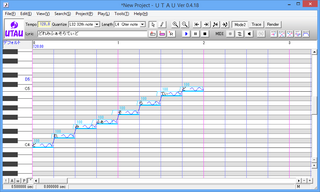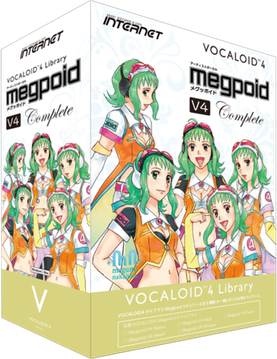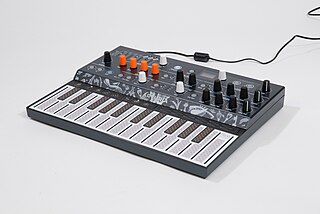Additive synthesis is a sound synthesis technique that creates timbre by adding sine waves together.
Speech synthesis is the artificial production of human speech. A computer system used for this purpose is called a speech synthesizer, and can be implemented in software or hardware products. A text-to-speech (TTS) system converts normal language text into speech; other systems render symbolic linguistic representations like phonetic transcriptions into speech. The reverse process is speech recognition.

Vocaloid is a singing voice synthesizer software product. Its signal processing part was developed through a joint research project between Yamaha Corporation and the Music Technology Group in Universitat Pompeu Fabra, Barcelona. The software was ultimately developed into the commercial product "Vocaloid" that was released in 2004.

The microKORG is a MIDI-capable digital synthesizer/vocoder from Korg featuring DSP-based analog modelling. The synthesizer is built in such a way that it is essentially a Korg MS-2000 with a programmable step arpeggiator, a less advanced vocoder, lack of motion sequencing, lack of an XLR microphone input, and in a smaller case with fewer real-time control knobs.
Linear arithmetic synthesis, or LAsynthesis, is a means of sound synthesis invented by the Roland Corporation when they released their D-50 synthesizer in 1987.
The Yamaha FS1R is a sound synthesizer module, manufactured by the Yamaha Corporation from 1998 to 2000. Based on Formant synthesis, it also has FM synthesis capabilities similar to the DX range. Its editing involves 2,000+ parameters in any one 'performance', prompting the creation of a number of third party freeware programming applications. These applications provide the tools needed to program the synth which were missing when it was in production by Yamaha. The synth was discontinued after two years, probably in part due to its complexity, poor front-panel controls, brief manual and limited polyphony.

The Korg RADIAS is a virtual analog synthesizer and Vocoder, released by Korg in 2006. The RADIAS' MMT engine was based on the Korg OASYS synthesizer module, providing for several different synthesis methods, two of which may be combined in a single voice e.g. phase distortion synthesis can be combined with subtractive synthesis. The different synthesis methods employed by MMT represent the majority of methods used historically in other Korg synthesizers: digital waveguide synthesis Korg first used in the Korg Z1 and phase distortion synthesis was first used in the Korg DS-8. This flexibility allows for very realistic emulations of past Korg synthesizers, though stays away from trying to emulate the Korg M1 and the Korg Wavestation,. As well as using the in-built waveforms for the basis of sound creation, the RADIAS allows for the input of an external signal which may be routed through the various sound shaping devices. The RADIAS has a comprehensive matrix modulation specification and to further enhance a sound the 'Wave Shaper' module allows for various sound distortion effects.

eSpeak is a free and open-source, cross-platform, compact, software speech synthesizer. It uses a formant synthesis method, providing many languages in a relatively small file size. eSpeakNG is a continuation of the original developer's project with more feedback from native speakers.

UTAU is a Japanese singing synthesizer application created by Ameya/Ayame (飴屋/菖蒲). This program is similar to the VOCALOID software, with the difference being it is shareware instead of under a third party licensing.

Internet Co., Ltd. or Internet, is a software company based in Osaka, Japan. It is best known for the music sequencer Singer Song Writer and Niconico Movie Maker for Nico Nico Douga, a video sharing website. It also develops singing synthesizers using the Vocaloid 4 engine developed by Yamaha Corporation. In 2014, they were the second leading company in sound-related software in Japan, boasting a 14.0% share of the market.

Voiceroid is a speech synthesizer application developed by AH-Software and is designed for speech. It is only available in the Japanese language. Its name comes from the singing software Vocaloid, for which AH-Software also develops voicebanks. Both AH-Software's first Vocaloids and Voiceroids went on sale on December 4, 2009.

PowerFX Systems AB, commonly referred to simply as PowerFX, is a small recording company, based in Stockholm, Sweden. The company has been producing music samples, loops and sound effects since 1995. They also developed singing synthesizers using the VOCALOID engine developed by Yamaha Corporation.
Vocaloid is a singing voice synthesizer and the first engine released in the Vocaloid series. It was succeeded by Vocaloid 2. This version was made to be able to sing both English and Japanese.

Vocaloid 2 is a singing voice synthesizer and the successor to the Vocaloid voice synthesizer application by Yamaha. Unlike the first engine, Vocaloid 2 based its output on vocal samples, rather than voice analysis. The synthesis engine and the user interface were completely revamped, with Japanese Vocaloids possessing a Japanese interface, as opposed to the previous version, which used English for both versions. It is noteworthy for introducing the popular character Hatsune Miku. It was succeeded by Vocaloid 3.

Vocaloid 3 is a singing voice synthesizer and successor to Vocaloid 2 in the Vocaloid series. This version of the software is a much more expansive version, containing many new features, three new languages and many more vocals than past software versions combined. It was succeeded by Vocaloid 4.

Vocaloid 4 is a singing voice synthesizer and successor to Vocaloid 3 in the Vocaloid series. It was succeeded by Vocaloid 5.

Harmor is a software synthesizer created by Image-Line Software for the music production program FL Studio. It is available as a demo version within the software; however, it must be purchased separately in order to save projects that contain Harmor instances. Harmor is an upgraded and more elaborate version of its predecessor, Harmless. It was originally released with a 32-bit engine and upgraded to a 64-bit engine in 2013.

Megpoid is a Vocaloid by Internet Co., Ltd. Her voice is sampled by Megumi Nakajima. The mascot of the software is called Gumi . She is also sometimes called Megpoid GUMI, or GUMI Megpoid.

Vocaloid 5 is a singing voice synthesizer and successor to Vocaloid 4 in the Vocaloid series. It was succeeded by Vocaloid 6.

The MicroFreak is a synthesizer manufactured by French music technology company Arturia and released in 2019. Described as a "Hybrid Experimental Synthesizer", it uses 18 digital sound engines (algorithms) to synthesize raw tones. This digital oscillator is then fed into a multi-mode analog filter, giving the MicroFreak its hybrid sounds.














